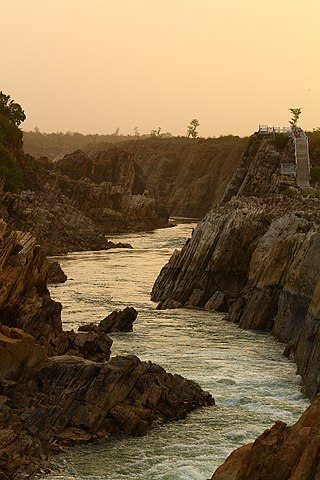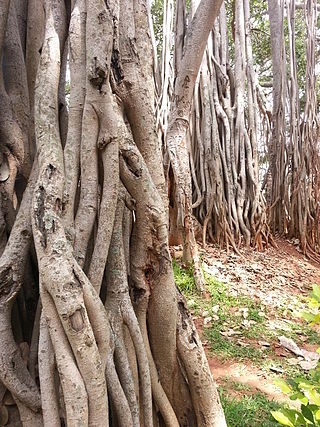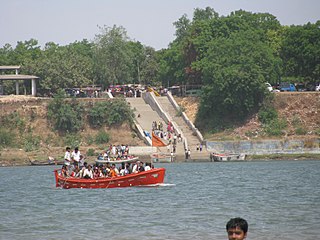
A banyan, also spelled banian, is a fig that develops accessory trunks from adjacent prop roots, allowing the tree to spread outwards indefinitely. This distinguishes banyans from other trees with a strangler habit that begin life as an epiphyte, i.e. a plant that grows on another plant, when its seed germinates in a crack or crevice of a host tree or edifice. "Banyan" often specifically denotes Ficus benghalensis, which is the national tree of India, though the name has also been generalized to denominate all figs that share a common life cycle and used systematically in taxonomy to denominate the subgenus Urostigma.

Ficus benghalensis, or Ficus indica commonly known as the banyan, banyan fig and Indian banyan, is a tree native to the Indian Subcontinent. Specimens in India are among the largest trees in the world by canopy coverage. It is also known as a "strangler fig" because like many other trees in the genus Ficus it starts out as epiphyte, that is, leaning on another tree that it ends up suffocating.

The Narmada River, previously also known as Narbada or anglicised as Nerbudda, is the 5th longest river in India and overall the longest west-flowing river in the country. It is also the largest flowing river in the state of Madhya Pradesh. This river flows through the states of Madhya Pradesh and Gujarat in India. It is also known as the "Lifeline of Madhya Pradesh and Gujarat" due to its huge contribution to the two states in many ways. The Narmada River rises from the Amarkantak Plateau in Anuppur district in Madhya Pradesh. It forms the traditional boundary between North and South India and flows westwards for 1,312 km (815.2 mi) before draining through the Gulf of Khambhat into the Arabian Sea, 30 km (18.6 mi) west of Bharuch city of Gujarat.

The Satpura Range is a range of hills in central India. The range rises in eastern Gujarat running east through the border of Maharashtra and Madhya Pradesh and ends in Chhattisgarh. The range parallels the Vindhya Range to the north, and these two east–west ranges divide Indian Subcontinent into the Indo-Gangetic plain of northern India and the Deccan Plateau of the south. The Narmada River originates from north-eastern end of Satpura in Amarkantak, and runs in the depression between the Satpura and Vindhya ranges, draining the northern slope of the Satpura range, running west towards the Arabian Sea. The Tapti River originates in the eastern-central part of Satpura, crossing the range in the center and running west at the range's southern slopes before meeting the Arabian Sea at Surat, draining the central and southern slopes of the range. Multai, the place of Tapti river origin is located about 465 kilometer far, south-westerly to Amarkantak, separated across by the hill range. The Godavari River and its tributaries drain the Deccan plateau, which lies south of the range, and the Mahanadi River drains the easternmost portion of the range. The Godavari and Mahanadi rivers flow into the Bay of Bengal. At its eastern end, the Satpura range meets the hills of the Chotanagpur Plateau. The Satpura Range is a horst mountain and is flanked by Narmada Graben in the north and much smaller but parallel Tapi Graben in the south.

Omkareshwar Temple is a Hindu temple dedicated to Shiva, located in Mandhata, nearby Khandwa city in Khandwa district of the Indian state of Madhya Pradesh. It is one of the 12 revered Jyotirlinga shrines of Shiva. It is on an island called Mandhata, near Khandwa city in the Narmada River at Khandwa district in Madhya Pradesh, India; the shape of the island is said to be like the Devanagari ॐ symbol.

There are 18 biosphere reserves in India. They protect larger areas of natural habitat than a typical national park or animal sanctuary, and often include one or more national parks or reserves, along with buffer zones that are open to some economic uses. Protection is granted not only to the flora and fauna of the protected region, but also to the human communities who inhabit these regions, and their ways of life. In total there are 18 biosphere reserves in India.

The Dodda Aalada Mara, literally translated to Big Banyan Tree, is a giant approximately 400-year-old banyan tree located in the village of Kethohalli in the Bengaluru Urban district of Karnataka, India. This single plant covers 3 acres (1.2 ha) and is one of the largest of its kind. In the 2000s, the main root of the tree succumbed to disease, and thus the tree now looks like many different trees. The Dodda Alada Mara is named a heritage tree.
The Indira Sagar Dam is the largest dam in India, in terms of volume of water stored in the reservoir. It is located on the Narmada River at the town of Narmada Nagar, Punasa in the Khandwa district of Madhya Pradesh in India. The foundation stone of the project was laid by the prime minister of India Indira Gandhi on 23 October 1984. The construction of the main dam started in 1992. The downstream projects of ISP are Omkareshwar, Maheshwar, and Sardar Sarovar Project. To build it, a town of 22,000 people and 100 villages was displaced.

The Narmada Valley dry deciduous forests are a tropical dry forest ecoregion of central India. The ecoregion lies mostly in Madhya Pradesh state, but extends into portions of Chhattisgarh, Maharashtra, Karnataka and Uttar Pradesh states.

India possesses a wide spectrum of dimensional stones including granite, marble, sandstone, limestone, slate, and quartzite, found across various parts of the country.
Kadiri is a major city in Sri Sathya Sai District the Indian state of Andhra Pradesh. It is a Special Grade Municipal City Council and headquarters of Kadiri Mandal and Kadiri Revenue Division. Kadiri Taluka ('Tehsil') was the largest taluk in the state of Andhra Pradesh when there was taluka system in Andhra Pradesh Kadiri is known for its jasmine and saffron flowers. Kadiri saffron is widely sold in Andhra and Karnataka. The Sri Lakshmi Narasimhaswamy Temple is reminiscent of Kadiri to the people of Karnataka, Telangana And Tamil Nadu. The name of Kadiri has also some interesting past. The habitation was initially named as Khadripuram as ‘khadara’ plants were largely found in the surrounding forests and Khadri has later transformed as Kadiri.

The Great Banyan is a banyan tree located in Acharya Jagadish Chandra Bose Indian Botanic Garden, Shibpur, Howrah, near Kolkata, India. The great banyan tree draws more visitors to the garden than its collection of exotic plants from five continents. Its main trunk became infected by fungi after it was struck by two cyclones, so in 1925 the main trunk of the tree was amputated to keep the remainder healthy. A 330-metre-long (1,080 ft) road was built around its circumference, but the tree continues to spread beyond it.

Gujarat is a state located in western India. Its north-western border, which is also the international border, is adjacent to Pakistan. Rajasthan and Madhya Pradesh are the states located in its north and north-east respectively. Maharashtra is to its south. The Arabian Sea forms its western-southern boundary. Dadar and Nagar-Haveli are on its southern border.

The Mahatma Gandhi Bus Station (MGBS), also known as the Imlibun Bus Station, is a bus station on the Musi River in the Imlibun area of southern Hyderabad, India. It is owned by the Telangana State Road Transport Corporation (TGSRTC) and is India's fifth-largest bus station, covering 20 acres (81,000 m2), behind Chennai Mofussil Bus Terminus, Bengaluru's Kempegowda Bus Station, Vijayawada's Pandit Nehru Bus Station and Delhi's Millennium Park Bus Depot.

Narmada Valley Development Authority (NVDA) concerns Narmada River, the river of Madhya Pradesh. With 87% of its catchment area lying in Madhya Pradesh, it becomes all the more important for the state to exploit this enormous water resource. It was with this motto in mind that the Narmada Valley Development Authority (NVDA) was formed by the government of MP on 9 August 1985. NVDA oversees all major development projects in the Narmada Basin. The body also ensures that proper rehabilitation is provided to the displaced, and the negative impacts on environment are minimized by taking appropriate measures.

Thimmamma Marrimanu is a banyan tree in Anantapur, located about 25 kilometers from Kadiri, Andhra Pradesh, India. It is probably a specimen of Ficus benghalensis. In the Telugu language, "marri" denotes "banyan" and "manu" denotes "trunk". Its canopy covers 19,107 m2, and it was recorded as the largest tree specimen in the world in the Guinness Book of World Records in 1989. The tree is revered by Hindus, Buddhists and Jains.
Forests Department, Haryana is a department of the Government of Haryana, a state in India, that runs and maintains many protected nature areas in the state of Haryana. It has two administrative divisions: Forest and Wildlife. The department is responsible for maintaining National Parks, Wildlife Sanctuaries and Conservation Reserves in Haryana. It also provides a special emphasis on Soil and Moisture Conservation works in the hills to conserve water and deliver it to adjacent farmlands. Two National Parks, eight Wildlife Sanctuaries, two Conservation Reserves, four Animal & Bird Breeding Centres, one Deer park, and 49 herbal parks. Kanwar Pal Gujjar has been the cabinet minister responsible for this department since October 2019. constitute the Protected Area network of the department, covering 0.75% of the state. It also maintains a list of Protected Areas in Haryana.

The Lahaina Banyan Tree is a banyan tree in Maui, Hawaii, United States. A gift from missionaries in India, the tree was planted in Lahaina on April 24, 1873, to mark the 50th anniversary of the arrival of first American Protestant mission. Covering 1.94 acres, the tree resides in Lahaina Banyan Court Park. A mere 8 feet (2.4 m) when planted, it grew to a height of about 60 feet (18 m) and rooted into 16 major trunks, apart from the main trunk, with the canopy spread over an area of about 0.66 acres (0.27 ha). It is considered the largest banyan tree in the state and the country. In April 2023, Lahaina held a birthday party to celebrate the Banyan Tree’s planting 150 years ago.

Kabirvad is a banyan tree located on a small river island in the Narmada River, in Bharuch district, Gujarat, India. The tree and place is associated with 15th-century mystic-poet Kabir, and the location includes a temple dedicated to him. The place is a religious site as well as a popular tourist spot.
















